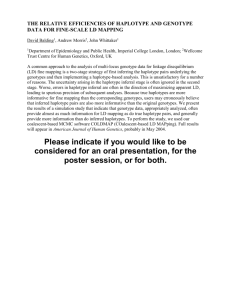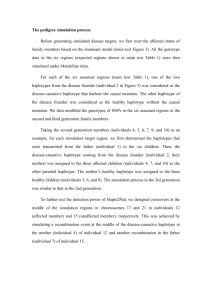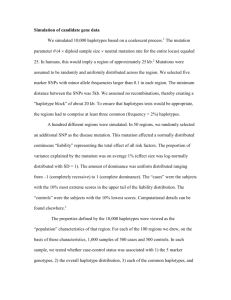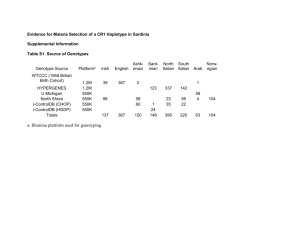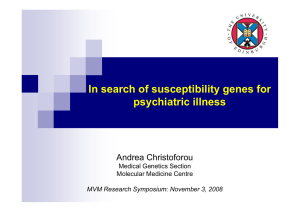slides
advertisement
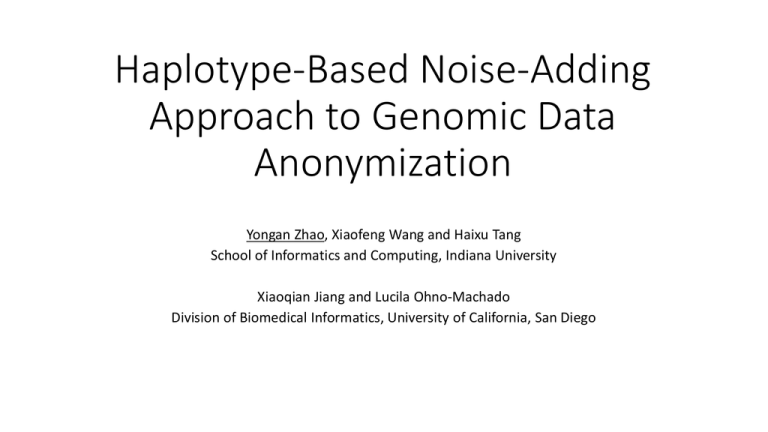
Haplotype-Based Noise-Adding Approach to Genomic Data Anonymization Yongan Zhao, Xiaofeng Wang and Haixu Tang School of Informatics and Computing, Indiana University Xiaoqian Jiang and Lucila Ohno-Machado Division of Biomedical Informatics, University of California, San Diego Applications on Human Genomic Data • Genome-Wide Association Studies: • Find putative disease-related genetic markers • Dig into big genomic data • 23andMe (https://www.23andme.com/) • PatientsLikeMe (http://www.patientslikeme.com/) • …… Privacy in Human Genomic Data • Phenotype inference • Re-identification risk by statistical inference techniques • Homer et al. • Sankararaman et al. • Wang et al. Homer, N., Szelinger, S., Redman, M., Duggan, D., Tembe, W., Muehling, J., … Craig, D. W. (2008). PLoS Genetics, 4(8), e1000167. doi:10.1371/journal.pgen.1000167 Sankararaman, S., Obozinski, G., Jordan, M. I., & Halperin, E. (2009). Nature Genetics, 41(9), 965–7. doi:10.1038/ng.436 Wang, R., Li, Y., Wang, X., & Tang, H. (2009). Proceedings of the 16th. Differential Privacy • 𝜖 Differential Privacy: A randomized algorithm 𝐴𝑔 is differentially private if for all datasets 𝐷 and 𝐷’, where their symmetric difference contains at most one record, and for all possible anonymized datasets 𝐷, Differential Privacy Cont’d • Sensitivity: For any function 𝜃: 𝐷 → 𝑅, the sensitivity of 𝜃 is for all 𝐷, 𝐷′ with |𝐷∆𝐷′ | ≤ 1. Naïve Algorithm • Treat each allele count pair (𝑓𝑚𝑖𝑛𝑜𝑟 , 𝑓𝑚𝑎𝑗𝑜𝑟 ) as a histogram • Sensitivity over 𝑛 SNP sites is 2𝑛 • Add Laplacian noises to 𝑓𝑚𝑖𝑛𝑜𝑟 , 𝑓𝑚𝑎𝑗𝑜𝑟 Naïve Algorithm Cont’d • Alleles from 262 to 277 on dataset 1 in task 1 Pos 262 263 264 265 266 267 268 269 270 271 272 273 244 275 276 277 Major T C T T C A C T T G T G C G C A Minor G A C C T G T A A A C C T A T G Results D1 D2 FDR # of significant SNPs Power 0.05 5e-2 19/263 0.844 22 1e-3 12/238 0.774 19 1e-5 9/217 0.700 14 Power 0.04 5e-2 42/565 0.924 45 1e-3 12/526 0.862 15 1e-5 5/480 0.788 8 Problem of Naïve Algorithm • High dimension of dataset (i.e., number of SNPs) • high sensitivity • For a population with 𝑚 alleles, the space of their SNP sequences in the population is not 2𝑚 • Too much noise needs to be added! Haplotype • Haplotype: • The specific combination of alleles across multiple neighboring SNP sites in a locus • Haplotype block (or haploblock) structure is an intrinsic feature of human genome • Haploblocks can be derived from public human genomic data, independent from any given (to-be-protected) sensitive case dataset Haplotype Cont’d • The first several haplotype blocks on dataset 1 in task 1 Haplotype Cont’d • Properties: • Inter-haploblock SNPs are more correlated than intra-haploblock SNPs • The number of potential SNP sequences in each haploblock is significantly lower than the theoretically exponential number • In each haploblock, some haplotypes are more frequent than others • Convert exponential space of SNP sequences to multinomial output Haplotype-based noise-adding • Break a genomic locus consisting of many SNPs into haplotype blocks • Treat each haplotype block as a random variable that takes a set of potential haplotypes in the block as its possible values • Different haplotypes can be viewed as independent from each other • Reduce the dimensions of the SNP sequences by effectively one order of magnitude (because an average haplotype block span ~10-30 SNPs) Haplotype-based algorithm • Haplotype blocks from 262 to 277 on dataset 1 in task 1 Block 9 Block 10 Block 11 TACCCGCTAGC TCTTCACTTGT GACTTACAAAC GACTCATTAAC GACTCACTAAT CT GC GTA ACA GCG GCA Results Naïve algorithm Haplotype-based algorithm FDR D1 D2 FDR # of significant SNPs Power 0.05 0.05 5e-2 19/263 0.844 22/246 0.775 22 1e-3 12/238 0.774 19/229 0.719 19 1e-5 9/217 0.700 14/209 0.657 14 Power 0.04 5e-2 42/565 0.924 45/537 0.869 45 1e-3 12/526 0.862 15/499 0.812 15 1e-5 5/480 0.788 8/357 0.579 8 0.085 Haplotype-based Algorithm with Unequal Weight • We need to allocate the privacy budget into haploblocks so that the total budget is not over-spent • Our previous approach allocates the same budget to each haploblock. Can we do this better? • Unequal budget allocation • Intuition: haploblocks with more haplotypes -> more complex distributions for SNPs -> more deviated from their actual values • Less noise to be added to more complex haploblocks (with more haplotypes) Haplotype-based algorithm with Unequal weight Cont’d • Haplotype blocks from 262 to 277 on dataset 1 in task 1 Block 9 (5) Block 10 (2) Block 11 (4) TACCCGCTAGC TCTTCACTTGT GACTTACAAAC GACTCATTAAC GACTCACTAAT CT GC GTA ACA GCG GCA Results Naïve algorithm Haplotype-based algorithm Unequal-weight haplotype-based algorithm FDR FDR FDR D1 D2 0.05 # of significant SNPs Power 0.05 0.03 5e-2 19/263 0.844 22/246 0.775 20/197 0.612 22 1e-3 12/238 0.774 19/229 0.719 19/163 0.493 19 1e-5 9/217 0.700 14/209 0.657 14/155 0.475 14 Power 0.04 5e-2 42/565 0.924 45/537 0.869 44/499 0.804 45 1e-3 12/526 0.862 15/499 0.812 15/437 0.708 15 1e-5 5/480 0.788 8/357 0.579 8/312 0.504 8 0.085 0.115 Future Works • Privacy preserved data selection • Privacy preserved big data sharing and processing Acknowledgement • NCBC-collaborating R01 (HG007078-01) from NIH/NHGRI.
